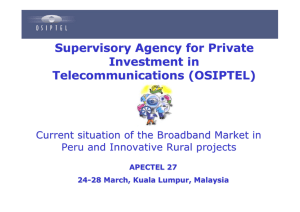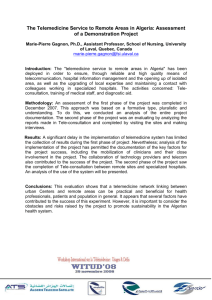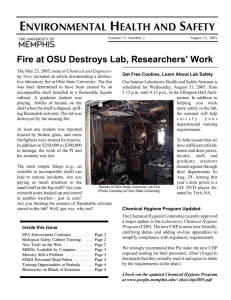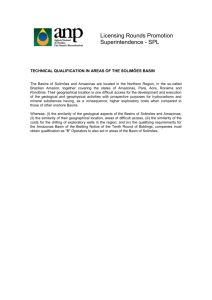PPT
advertisement
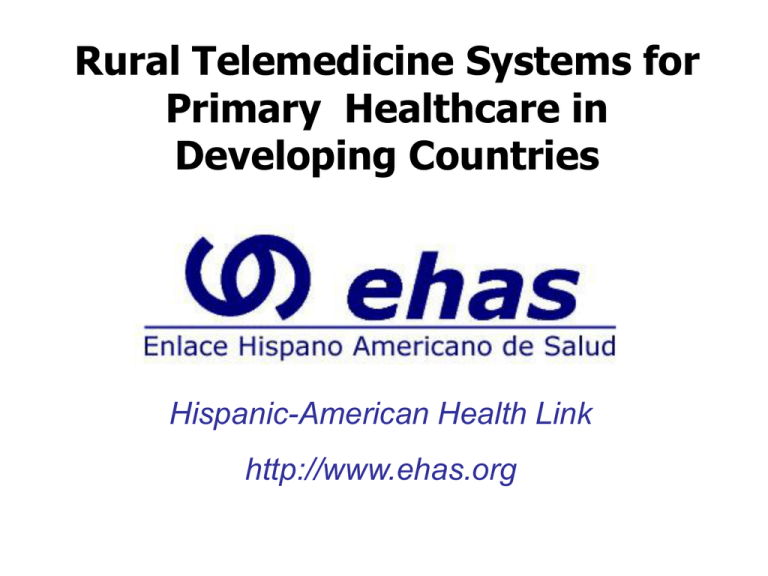
Rural Telemedicine Systems for Primary Healthcare in Developing Countries Hispanic-American Health Link http://www.ehas.org Participant institutions – Spain: • Group of Bioingeniering and Telemedicine (GBT) of the Polytechnical University of Madrid • The NGO Engineering Without Borders (ISF) • The Foundation for the Cooperation and International Health Carlos III (FCSAI) • The University Carlos III of Madrid (UC3M) – Peru: • Pontifical Catholic University of Peru (PUCP) • Peruvian University Cayetano Heredia (UPCH) • Andean organism of Health - Agreement Hipólito Unanue – Colombia: • University of the Cauca (UniCauca) – Cuba: • Network Telematics of Medical Information of Cuba (Infomed) • Center of computer science development for the public health (CEDISAP) – Portugal: • Institute of Hygiene and Tropical Medicine – United Kingdom: • London School of Hygiene & Tropical Medicine Objective of ehas program To start up national conditions to employ appropriated telemedicine systems for rural primary health care (low cost and adapted to local needs) The ehas proposal Appropriated telemedicine systems Information services for rural healthcare needs Appropriated and low cost communication technology The ehas services Voice communication e-mail Distance training Electronic publications Distance consultation Access to remote health information Support for epidemiological surveillance Support for drug delivery The ehas technology Developed by ehas partners and mainly based on: Radiocommunication Solar energy Free software Pilot Project Alto Amazonas Peru Alto Amazonas Province Total: 93 health establishments Loreto Departament Pilot Project: 41 establishments Health Center Reference center for Health Post In district capitals Usually have telephone line Access to electricity (4 hours) Headed by physicians 5 to 10 workers Allows hospitalization Health Post Lowest in the hierarchy Managed by Health Center Small towns Difficult access No telephone lines No electricity 1 worker (infirmary technician) Low trained personnel Problem situation in Alto Amazonas Scare infrastructures Long distances High cost in communications Difficulties on sending information Coordination problems Health personnel: young, low experience, high rotation and an isolation feeling The equipment at the Health Posts Laptop Printer Desk VHF radio and modem The equipment at the Health Posts Solar system Tower and antenna The equipment at the Health Center Laptop, VHF radio, printer, and... Battery loader Email server Battery group Email server How it works? The rest of the Internet National EHAS Center Radio network Local communications RPTC INTERNET Health Post #2 I.S.P. Ethernet Health Center Medical libraries INTERNET Research Centers VHF RADIO LINK Health Post #1 Hospitals Uses of the system There are local contributions from the province government, the local councils and the communities Training in the use of computers There is a continuous work on organizational changes Some evidences (I) Use of the system (percentage of high use) Voice: 84% email: 27% Computer:73% Usefulness for consultation Consultations per establishment have increase 700% Usefulness for distance training Appropriated distance training for 95% Some evidences (II) Acceptance Users: the system improves their jobs, reduces their tasks and allows a better healthcare Management: the system is appropriated and useful Some conclusions Good evidences of positive impact in healthcare system But, more organizational changes are needed into the Alto Amazonas healthcare system, and The local maintenance program has to be improve EHAS technology now HF • • • • • Use of soundcard as modem. New QPSK modulation. 2400 bps over noising HF channels Email. Software based on Linux. VHF • • • • Use of soundcard as modem. PSK modulation. 9600 bps over 12.5 kHz VHF/UHF radio channels. Email. EHAS technology now WiFi RadioLinks installed in Colombia Use of Teletronics CPE routers (www.teletronics.com/tii/products/routers/c pe.html) On Research 1. WiFi: 1. 2. 3. Design of solar wireless routers QoS for Voice transmission over wireless networks Interconexion of VoIP and PSTN 2. HF: 1. 2. 3. Improvement of Newqpsk modem Testing of new M-PSK based modulations Implementation of a chat system to communicate with system like Yahoo Messenger, MSN. OFDM Spectrum of newQPSK On Research: 3. Lightning Protection: Polyphaser Test a two models using ESD high voltage generator: 1. 2. 3. in the IS-B50, at voltages less than 3.7 kV, the current flow through the protector (from antenna side to equipment side). the IS-C50 worked fine, none time (at voltages: 2, 3, 5, 10 y 20 kV) the current flow through the protector, the fuse work at 3.7 kV or more, before no IS-C50 modificated (short circuited its lines) was the worse. Al the time, the current flow across it Preliminar Conclusion: the ideal protector should have nothing (paralell lines) between antenna and radio like the IS-C50. Response of Maker: Polyphaser devices are tested using 8/20 us wave (IEC-6100-4-5). Your generator use 1/30 ns Last news!! • 03/11/2003 Meeting of all partners for take decisions about @LIS Proyect • 20/01/2004 EHAS finalist in the Stockholm Challenge: http://www.challenge.stockholm.se/finalists. asp?Ar=2003&key=39KV85332
